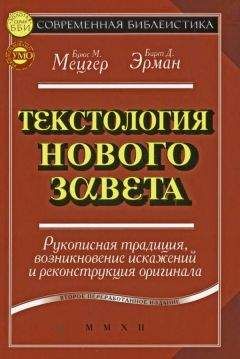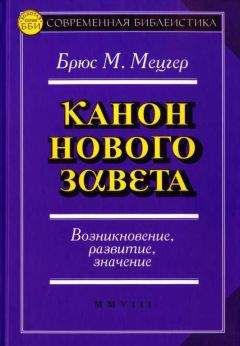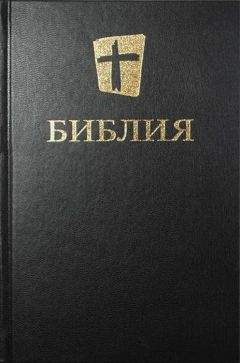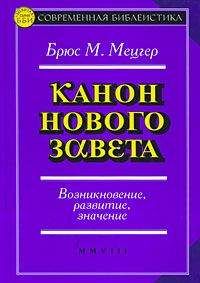423
См. Erroll F. Rhodes, «Conjectural Emendations in Modern Translations», New Testament Textual Criticism, ed. by Epp and Fee, pp. 361–380. См. также P. W. Comfort, Early Manuscripts and Modem Translations of the New Testament (Wheaton, IL, 1990).
См. B. D. Ehrman, «Methodological Developments in the Analysis and Classification of New Testament Documentary Evidence», Novum Testamentum, xxix (1987), pp. 22–45.
Edward Ardron Hutton, An Atlas of Textual Criticism, Being an Attempt to Show the Mutual Relationship of the Authorities for the Text of the New Testament up to About 1000 A. D. (Cambridge, 1911).
E. C. Colwell, «Method in Locating a Newly-Discovered Manuscript within the Manuscript Tradition of the Greek New Testament», Studia Euangelica…, ed. by Kurt Aland et al. (Texte und Untersuchungen, lxxiii; Berlin, 1959), p. 759, перепечатано в его Studies in Methodology in Textual Criticism of the New Testament (Grand Rapids, MI, 1969), pp. 26–34.
См. пересмотренные и обновленные варианты работ Колуэлла в его Studies in Methodology in Textual Criticism, особенно «Method in Locating a Newly-Discovered Manuscript», pp. 26–44, и «Method in Establishing Quantitative Relationship Between Text-Types of New Testament Manuscripts» (в соавт. с Эрнестом Тьюном (Tune), pp. 56–62.
Метод также был использован для того, чтобы продемонстрировать связи Синайского кодекса с Западным текстом в первых главах Ин (Gordon Fee, «Codex Sinaiticus in the Gospel of John: A Contribution to Methodology in Establishing Textual Relationships», New Testament Studies xv [1968–1969], pp.23–44); проследить возникновение и развитие александрийского типа текста (idem, «Origen’s Text of the New Testament and the Text of Egypt», New Testament Studies 28 [1982], pp. 284–264; idem «p75, p66, and Origen: The Myth of Textual Recension in Alexandria», New Dimensions in New Testament Studies, ed. by Richard N. Longenecker and Merrill C. Tenney [Grand Rapids, MI, 1974]; Bart D. Ehrman, Didymus the Blind, and the Text of the Gospels [Athlanta, 1986]); опровергнуть предположения о «докесарийском типе текста Евангелий» (Larry Hurtado, Text-Critical Methodology and the pre-Caesarian Text: Codex W in the Gospel of Mark [Grand Rapids, MI, 1981]); определить текстуальные связи для сохранившихся свидетелей текста посланий Иоанна (W. L. Richards, The Classification of the Greek Witnesses of the Johannine Epistles [Missoula, MT, 1977]); и установить текстуальные связи для ряда патристических источников, см. p. 239, п. 71.
См. далее Klaus Wachtel, «Colwell Revisited: Grouping New Testament Manuscripts», в New Testament in Early Christianity: Proceedings of the Lille Colloquium, July 2000, ed. by Christian-B. Amphoux and J. Keith Elliott (Lausanne, 2003), pp. 31–43.
Другой важный метод классификации рукописей был разработан Гердом Минком (Gerd Mink) и назван «локальным генеалогическим методом». Метод устанавливает генеалогические связи между чтениями той или иной рукописи, определяя, какая форма текста является первоисточником ее вариаций (если таковые имеются). Когда эта работа проделана для всех вариантных чтений книги, результаты заносятся в таблицу, по которой можно определить, какие тексты (обнаруженные в одних рукописях) вероятно оказываются производными от других (находящихся в других рукописях), и, таким образом, основываясь на данных текстов, можно составить генеалогическое древо рукописей. См. G. Mink, «Eine Umfassende Genealogie der neurestamentlichen Überlieferung», New Testament Studies, xxxix (1993), pp. 481–499. Практическое применение метода см. Matthew Spencer, Klaus Wachtel, Christopher J. Howe, «The Greek Vorlage of the Syra Harclensis: A Comparative Study on Method in Exploring Textual Genealogy», TC: A Journal of Biblical Textual Criticism [http://purl.org/TC] vii (2002), pars. 13–24.
Принципы, на которых основан Клермонтский метод профиля, и результаты его применения были впервые изложены в статье: Eldon Jay Epp, «The Claremont Profile-Method for Grouping New Testament Minuscle Manuscripts», в Studies in the History, ed. by Boyd L. Daniels and M. Jack Suggs (Studies and Documents 29; Salt Lake City, UT, 1967), pp. 27–37; исчерпывающий отчет об истории метода и используемых процедурах, а также обсуждение применения по отношению к рукописям Лк можно найти в: Frederick Wisse, The Profile Method for the Classification and Evaluation of Manuscript Evidence as Applied to the Continuous Text of the Gospel of Luke (Studies and Documents 44; Grand Rapids, MI, 1982); о дальнейшем применении этого метода см. David C. Parker, «A Comparison Between the Text und Textwert and the Claremont Profile Method Analyses of Manuscripts in the Gospel of Luke», New Testament Studies, li (2000), pp.108–138.
Список рукописей, отнесенных к соответствующим категориям см. Kurt Aland and Barbara Aland, The Text of the New Testament: An Introduction to the Critical Editions and to the Theory and Practice of Modem Textual Criticism, trans. by Erroll F. Rhodes (Grand Rapids, MI, 1987), pp. 83-160.
Пример применения метода классификации Аланда в сочетании с квантитативным методом, когда рукопись сначала отбиралась по «проверочным отрывкам» затем производилась оценка полных колляций по отношению к ряду свидетелей, см. Wachtel and Howe, op. cit., pars. 4-12.
См. Bart D. Ehrman, «The Use of Group Profiles for the Classification of New Testament Documentary Evidence», Journal of Biblical Literature, cvi (1987), pp. 465–486; idem, Didymus the Blind, pp. 223–253.
См. Ehrman, Didymus the Blind; Darrel D. Hannah, The Text of 1 Corinthians in the Writings of Origen (Atlanta, 1997). Roderic L. Mullen, The New Testament Text of Cyril of Jerusalem (Atlanta, 1997). Последующие тома в серии посвящены Афанасию [Великому] (John Brogan), Василию Великому (Jean-François Rasine), Епифанию (Carroll Osburn).
См. напр., прототип edition critica maior мюнстерского Института текстологических исследований Нового Завета (http://nestlealand.uni-muenster.de).
См. вступительное слово Бонифация Фишера «Computer und der Text des Neuen Testamentes», Studia Euangelica, vi (Berlin, 1973), p. 109: «Сегодня, говоря о применении компьютера, исследователь Нового Завета может больше не опасаться того, что его не будут воспринимать всерьез».
Работа Эллисона, «The Use of Electronic Computers in the Study of the Greek NT Text», (Diss., Boston, 1957), завершенная в 1957 г., была начата уже в 1950-м. Исследования в данной области от Эллисона до 1995 года см. Robert A. Kraft, «The Use of Computers in New Testament Textual Criticism», in The Text of the New Testament in Contemporary Research, ed. by Ehrman and Holmes, pp. 268–282.
См., например, Wilhelm Ott, «Transcription and the Correction of Text on Paper Tape: Experiences in Preparing the Latin Bible Text for the Computer», LASLA Revue, ii (1970), pp.51–56; idem, «Computer Applications in Textual Criticism», in The Computer and Literary Studies, ed. by J. Aitken, et al. (Edinburgh, 1973), pp. 199–223; Bonifatius Fischer, «The Use of Computers in NT Studies, with Special Reference to Textual Criticism», Journal of Theological Studies, n. s., xxi (1970), pp. 297–308; idem, «Computer und der Text», Studia Euangelica. См. также Vinton A. Dearing, «Determining Variations (in the Greek NT Text) by Computer», Society of Biblical Literature Seminar Papers, ii (1974), pp. 14–35; idem, Principles and Practise of Textual Analysis (Berkeley, 1974).
Kraft, op. cit.
См. David C. Parker, «The Text of the New Testament and Computers: The International Greek New Testament Project», Literary and Linguistic Computing, xv (2000), pp. 27–41; Klaus Wachtel, «Editing the Greek New Testament on the Threshold of the Twenty-first Century», Literary and Linguistic Computing, xv (2000), pp. 43–50.
Для доступа к ресурсам в Интернет см. обновленные ссылки на странице NT Gateway, созданной и поддерживаемой Марком Гудакром (Goodacre) в Университете Бирмингема (www.ntgateway.com/resource/textcrit.htm).
См.
Более современные методы использования компьютеров с применением сложных статистических моделей для классификации рукописей см.: J. C. Thorpe, «Multivariate Statistical Analysis for Manuscript Classification», T-C: A Journal of Biblical Textual Criticism (http://purl.org.tc) vii (2002); Spencer, Wachtel and Howe, op. cit., pars. 25–38.
D. C. Parker, «Through a Screen Darkly: Digital Texts and the New Testament», Journal for the Study of the New Testament, xxv (2003), p. 409.
Изданы в серии Arbeiten zur neutestamentlichen Textforschung (Berlin, 1987–1999).
Также изданы в серии Arbeiten zur neutestamentlichen Textforschung (Berlin, 1986–1994).
См. прим. 339.
The New Testament in Greek IV: The Gospel According to St. John, vol. i, The Papyri, ed. by W. J. Elliott and D. C. Parker (New testament Tools and Studies, xx; Leiden, 1995).
The New Testament in Greek IV, volume ii, The Majuscules (Leiden, 2007).
Это издание не содержит транскрипции самых длинных рукописей — p66 и p75, так как оно уже доступно в публикации коллекции Бодмера; см. Также и том с маюскулами представляет транскрипцию только 36 фрагментов источников, хотя разночтения 28 полных маюскульных рукописей включены в критический аппарат.
Для всех папирусов, вновь за исключением p66 и p75, даются полные фотовоспроизведения; из других включены отдельные характерные листы; в томе с маюскулами даны полные фотокопии рукописей, сохранившихся фрагментарно и образцы страниц для полных рукописей.
См.





